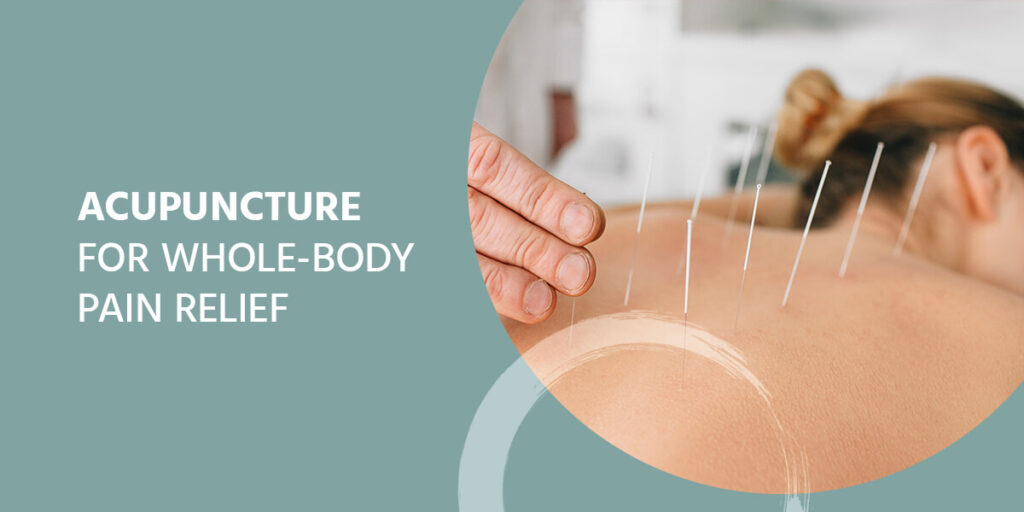
In this article:
- How Acupuncture Can Help With Pain Relief
- Acupuncture for Back Pain and Sciatica
- Acupuncture for Head, Face and Neck Pain
- Acupuncture for Knee Pain
- Acupuncture for Foot Pain
- Acupuncture for Hip Pain
- Acupuncture for Chronic Pain
- What to Expect at An Acupuncture Appointment
- Contact Won Institute for an Appointment
Acupuncture can provide temporary pain relief no matter where on your body you experience it. Keep reading to learn more about how acupuncture helps with pain relief and the areas where it’s most effective.
How Acupuncture Can Help With Pain Relief
Acupuncture is rooted in Traditional Chinese Medicine (TCM) and is based on its understanding of Qi. Qi is a Mandarin word that translates to “vital energy” or “vapor” in English. According to TCM, this vital energy flows through several pathways in our body called meridians. As it does so, it helps to balance our health and wellness. Therefore, a guiding principle in TCM is that illness, pain and disease occur when there are blockages or imbalances in a person’s Qi.
Acupuncture is a standard method of rebalancing this vital energy flow. TCM acupuncture practitioners insert tiny needles into strategic points in the body known as acupoints. These needles access the Qi meridians and help rebalance the energy flow, which helps the body overcome pain, illness and disease.
The body has at least 362 acupoints and likely many more than that. However, a typical acupuncture session only focuses on acupoints that relate to where the patient experiences pain. For example, acupuncture for lower back pain involves the placement of needles in that area. In other treatments, such as acupuncture for shoulder pain, meridians in other areas of the body may connect with the problem area. In these cases, the acupuncturist may also stimulate those pathways with acupuncture needles.
Western medicine has developed a somewhat compatible understanding of how acupuncture relieves pain. Although scientists are still seeking explanations, western medical research suggests that acupuncture may release endorphins and other chemicals. Endorphins provide pain relief while the other chemicals improve blood pressure and circulation, both of which are integral to healing.
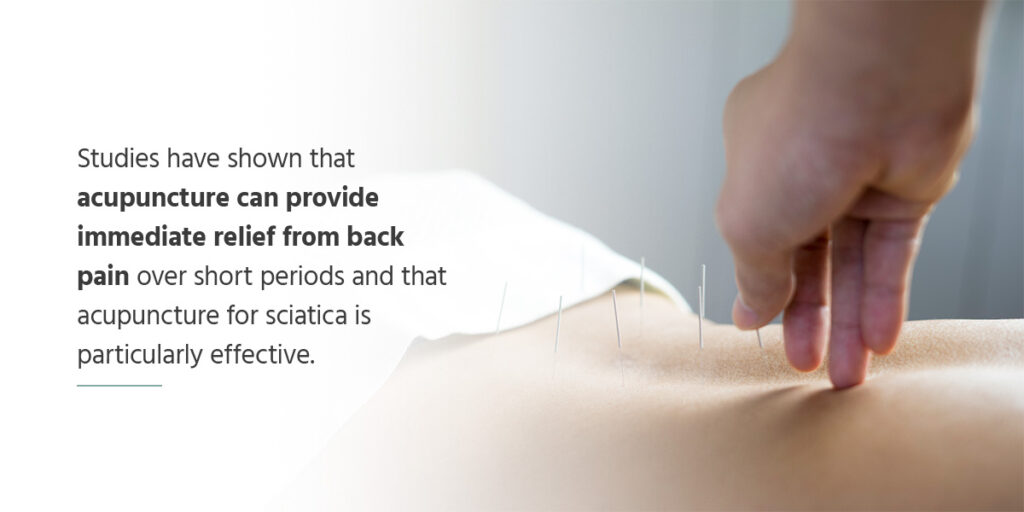
Acupuncture for Back Pain and Sciatica
Lower back and sciatica pain are two common reasons people seek acupuncture treatment. Acupuncture can enhance the effects of other treatments and improve routine function for patients, helping them get through their days without experiencing debilitating pain.
Sciatica is a condition where individuals experience radiating pain along their sciatic nerve, which runs from the lower spine, through the buttocks and down each leg. When other spinal conditions compress the sciatic nerve it can become irritated and inflamed, and patients experience pain that travels along its path. Patients with sciatica may also experience numbness and tingling from their lower back down to their feet.
Sciatica pain occurs in the lower back, buttocks and legs. Since acupuncture often addresses pain problems in the areas they affect, acupuncture for sciatica pain involves stimulating acupoints there. The needles engage the affected area, reducing muscle tension and increasing circulation. They also trigger a release of endorphins to the affected nerve, promoting pain relief.
Studies have shown that acupuncture can provide immediate relief from back pain over short periods and that acupuncture for sciatica is particularly effective. It provides a temporary solution for these issues, offering patients freedom from pain as they seek more permanent solutions.
It may take several sessions before patients experience noticeable results, depending on the extent of their condition and whether it is acute or chronic. Doctors define an acute condition as any injury or illness that occurs suddenly and is limited in duration. In contrast, chronic conditions are those that develop and worsen over an extended, indefinite time frame.
Acupuncture for Head, Face and Neck Pain
You may be wary of having needles in or around your face and head. However, acupuncture for nerve pain, joint dysfunction or other causes of head, face or neck pain is painless. In fact, many patients find the entire acupuncture process quite relaxing!
Acupuncture for TMJ Pain
You have a temporomandibular joint (TMJ) on either side of your head, connecting your lower jaw to your skull. TMJ pain affects the ligaments and muscles around your jaw joints, manifesting as jaw tenderness, earaches, headaches or facial pain.
Acupuncture relieves TMJ pain by relaxing the muscles surrounding the joint. This process involves the placement of several needles around the TMJ joint. The acupuncturist may also insert needles in areas with meridian connections with the TMJ area, such as the elbow, knees and big toes.
Acupuncture for TMJ dysfunction is most effective when neuromuscular damage is the underlying cause rather than joint tissue damage.
Acupuncture for Trigeminal Neuralgia Pain
The trigeminal nerve carries pain signals from the face to the brain. It begins at the ear and branches out toward your cheek, eye and jaw. Trigeminal neuralgia pain occurs along this nerve and may be especially bad when chewing food, smiling or speaking.
Acupuncture for trigeminal neuralgia involves needle placement in the area between the cheek, eye and jaw. Research shows that it can reduce trigeminal neuralgia pain and shorten treatment periods. It also has minimal risk of adverse effects.
Acupuncture for Other Areas
Acupuncture can help with several other forms of head, face and neck pain, including:
- Dental pain: Acupuncture can ease pain caused by tooth extractions or other dental surgeries. If you’re experiencing lingering pain after such a dental procedure, the analgesic effects of acupuncture can help. It can also reduce inflammation in the affected area and increase blood flow to stimulate healing.
- Migraines and tension headaches: Evidence has shown that acupuncture relieves migraine and headache pain. The best explanation is that acupuncture helps relieve migraine and tension headaches by providing an endorphin release, balanced energy levels and improved blood flow.
- Whiplash: Whiplash causes strained or sprained tissues in your neck, leading to significant neck pain. Acupuncture for neck pain relaxes your muscles and increases circulation, easing the pain and helping the damaged tissues heal quicker.
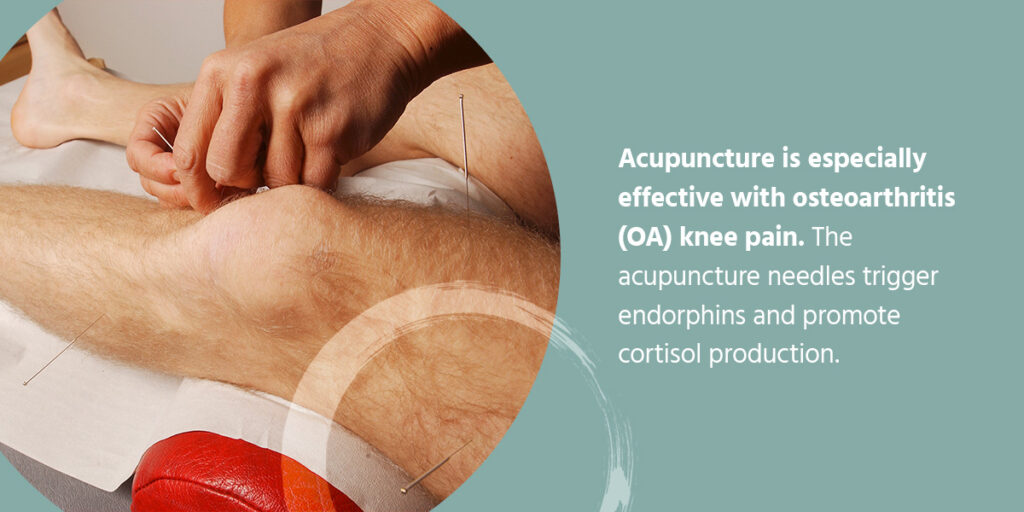
Acupuncture for Knee Pain
Whether you experience knee pain from arthritis or injury, acupuncture can help by reducing your pain for days or even weeks. The length of time an acupuncture treatment can reduce your knee pain varies according to the extent of the damage.
Acupuncture is especially effective with osteoarthritis (OA) knee pain. The acupuncture needles trigger endorphins and promote cortisol production. Cortisol is a hormone that reduces inflammation and the flow of endorphins, and cortisol can reduce pain sensitivity.
Acupuncture for Foot Pain
Acupuncture can help with several types of foot pain, including plantar fasciitis. Your plantar fascia is the band of tissue that forms the arch of your foot, connecting your heel bone to the metatarsal bones of your toes. Plantar fasciitis occurs when this tissue becomes inflamed, stretched or torn.
Plantar fasciitis can cause pain when walking or standing, interfering with your daily life. Common causes of plantar fasciitis include:
- Wearing shoes with poor cushioning.
- Frequent running or jogging.
- Standing for long periods.
An acupuncturist treats plantar fasciitis by placing several needles on the soles of your feet. This acupuncture method stimulates adenosine release to reduce inflammation. Adenosine is a hormone that also promotes blood flow throughout your body. Acupuncture for plantar fasciitis encourages the blood flow to go to your heels and the soles of your feet, making it particularly beneficial for foot pain.
Acupuncture for Hip Pain
Hip pain from bursitis can improve with acupuncture. Bursitis is a repetitive strain injury. When you strain or overuse your hip, your bursae — fluid sacs surrounding the hip joint — become inflamed. Like any injury with inflammation, bursitis improves with increased blood flow. As it does for plantar fasciitis, acupuncture stimulates the release of adenosine, making it an effective treatment option.
Other hip injuries and conditions that improve with acupuncture include:
- Hip fractures
- Hamstring injuries
- Hip arthritis
- Hip labral tears
- General or nonspecific hip pain
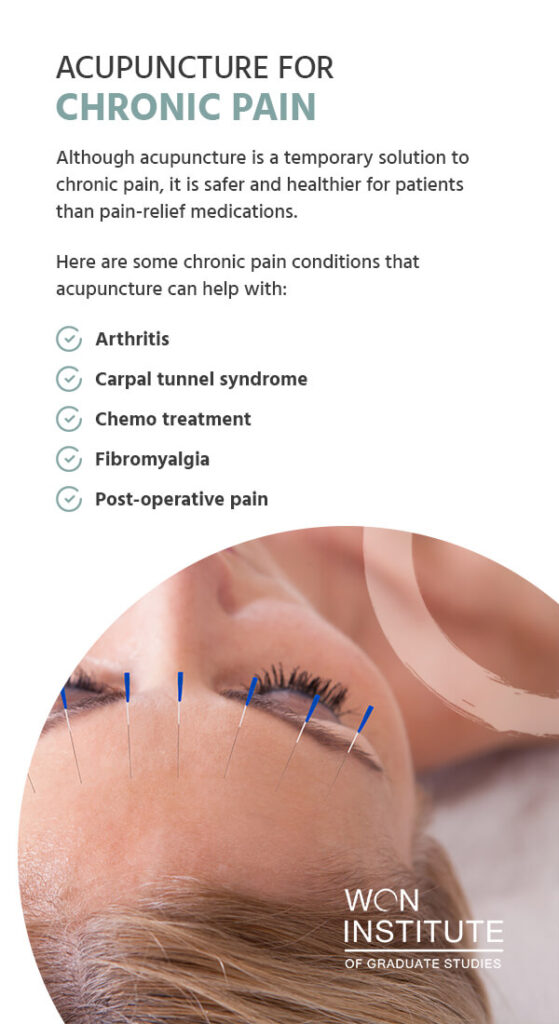
Acupuncture for Chronic Pain
Although acupuncture is a temporary solution to chronic pain, it is safer and healthier for patients than pain-relief medications. You can also book unlimited acupuncture appointments, making it a helpful complementary remedy to add to prescription pain relief. While acupuncture may not be the sole solution, it can help you cope with ongoing chronic pain in your daily life.
Here are some chronic pain conditions that acupuncture can help with:
- Arthritis: Acupuncture is an excellent complementary treatment for people with arthritis. Treatment is typically most effective for knee or spinal OA.
- Carpal tunnel syndrome: Patients have found that acupuncture for carpal tunnel can relieve pain in the hand, wrist and arm. Carpal tunnel begins in the palm side of the hand and extends up the forearm. Acupuncturists treat carpal tunnel pain by inserting needles into the palm and several spots along the wrist and forearm.
- Chemo treatment: Acupuncture can relieve unpleasant chemotherapy symptoms, such as pain, nausea and vomiting. Some patients also find that acupuncture also reduces the anxiety and depression associated with chemotherapy.
- Fibromyalgia: Fibromyalgia is a condition where individuals feel pain in their muscle fibers in several areas of the body. Patients also note symptoms of fatigue, joint stiffness and reduced function. Besides pain relief, acupuncture may also enhance the effect of other fibromyalgia therapies and provide relief from symptoms such as fatigue and anxiety.
- Post-operative pain: Stimulating acupoints near the spinal vertebrae can relieve post-operative pain. In some cases, acupuncturists and surgeons coordinate to insert intradermal needles before an operation. These needles remain in place during the surgery to limit post-operative pain. The endorphins that acupuncture releases have an analgesic effect, reducing the patient’s pain.
What to Expect at An Acupuncture Appointment
If you are making your first acupuncture appointment, you may wonder what to expect.
Consultation
Every patient’s first visit starts with a brief consultation with the acupuncturist. During this consultation, you will discuss:
- Your symptoms.
- When your pain started.
- Relevant aspects of your medical history.
- Any conditions or medications you’re taking that could complicate acupuncture treatment.
In many ways, your acupuncture consultation will mirror any other medical consultation. The goals of the consultation are to discover how the acupuncturist can best help you and verify that you can safely receive acupuncture. Some conditions and situations where doctors may recommend against acupuncture include:
- Bleeding disorders, such as anemia or hemophilia.
- Taking blood-thinning medication.
- Pregnancy, as acupuncture is decided on a case-by-case basis for pregnant individuals.
The consultation is also a good time to tell the acupuncturist about any fears, hesitations or phobias you have about needles. Letting them know well in advance will give them time to answer your questions and prepare any special accommodations.
Acupuncture Session
If everything looks good, the acupuncturist can proceed with your acupuncture session. You’ll decide together if the session will take place at a later date or immediately after the consultation. The acupuncturist will also establish a treatment plan with you. This way, you can know how many sessions you’ll need to have before you should start expecting results.
The acupuncture room will be decorated and organized to maximize your relaxation during the session. You may hear tranquil music, smell calming scents and see dim lighting to create a peaceful, relaxing experience.
To begin an acupuncture session, the acupuncturist will ask you to lie down on a sterile padded table. They will also give you the privacy to remove clothing or change into a gown if necessary. Once you’re ready, they will carefully examine the problem area and ask what kind of sensations you feel as they do so.
The acupuncturist will sterilize the area with rubbing alcohol before inserting any needles. While you may feel a slight pinch when they insert the needles, that is the full extent of any pain you should experience. After they’ve inserted the needles with a gentle tapping motion, you should enter a state of relaxation. The needles will remain for around 20-25 minutes as you lie comfortably on the table. Most acupuncture sessions last 30 minutes to one hour in total.
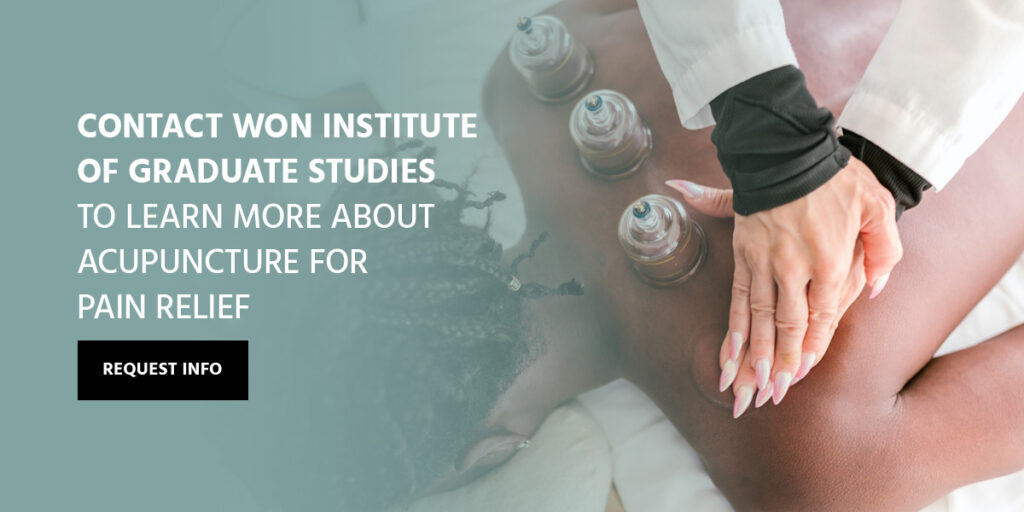
Contact Us to Learn More About Acupuncture for Pain Relief
No matter where you experience pain, it can make your daily life more challenging than it needs to be. In such cases, acupuncture may be a suitable option to help you recover from your pain and face each day with courage.
If you’d like to learn more about how acupuncture can help you or want to see an acupuncturist for a consultation, we’d love to help you at the Won Institute of Graduate Studies! We welcome you to contact one of our clinics for an acupuncture appointment.